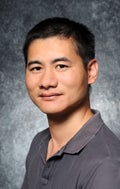
The College of Natural and Agricultural Sciences at UC Riverside welcomes 15 new faculty to its ranks during the 2014-15 academic year.
Nicolas Barth
Assistant Professor of Geology
Department of Earth Sciences
Degree
Ph.D., University of Otago, New Zealand, Geology
Research
Barth's research focuses on improving our understanding of active faults and their effects on the evolution of landscapes. Through on-the-ground fieldwork, scientific drilling, GIS analyses, lab analyses, and often broad collaborations he provides data on the properties of fault zones and the effects of large magnitude earthquakes (such as ground shaking, surface rupture, tsunamis, landslides). Results are utilized for geophysical/hazard models of earthquakes and city planning with the ultimate goal of mitigating hazards. His research currently focuses on the plate boundaries within New Zealand and California, two analogous fault systems expecting damaging large magnitude earthquakes in the near future.
Travis M. Bean
CE Assistant Weed Science Specialist
Department of Botany and Plant Sciences
Degree
Ph.D., University of Arizona, Natural Resources
Research
Invasive and weedy plants are an increasingly important management issue in wildlands, agricultural and horticultural systems, urban areas, and their interfaces. Because the general biology and ecology of some undesirable plants are poorly understood, effective deterministic management tools are not available. As a consequence, many well-intentioned management efforts proceed without knowledge and tools that may be key to successful control. Bean’s research focuses on 1) improving treatment efficacy and reducing unintended consequences of invasive and weedy plant control efforts, particularly from herbicides; 2) determining predictors of different phenological stages to identify opportunities for management; and 3) creating and adapting novel technologies to improve monitoring efficiency and track population growth.
Andrey Bekker
Assistant Professor in Biogeochemistry
Department of Earth Sciences
Degree
Ph.D., Virginia Polytechnic Institute and State University
Postdoc
Harvard University
Geophysical Laboratory, Carnegie Institution of Washington
Research
Bekker’s research focuses on both short- and long-term interactions between plate tectonics, mantle processes, and evolution of surface environments (including atmosphere and ocean) and life on early Earth. Surface environments and life co-evolved in response to plate tectonic and mantle drivers and influenced climate conditions. To understand underlying links and controls requires detailed interrogation of the geological record, which he does by integrating sedimentalogic and geochemical data for sedimentary rocks. Current research includes rises and falls of atmospheric oxygen, biogeochemical carbon cycle, ocean oxygenation events, and climate changes on early Earth.
Timothy Blass
Assistant Professor of Mathematics
Department of Mathematics
Degree
Ph.D., University of Texas at Austin, Mathematics
Postdoc
Carnegie Mellon University
Research
Developing and investigating mathematical models of physical systems, like the motion of fluids or the deformations of solid bodies under stress, allows us to better understand those systems and make predictions about their behavior. Blass uses tools from the theories of partial differential equations and dynamical systems to answer questions about such systems through analysis of mathematical models. This is done by improving and advancing the mathematical theories as well as developing computational techniques for performing computer simulations.
Weifeng Gu
Assistant Professor of Cell Biology & Neuroscience
Department of Cell Biology & Neuroscience
Degree
Ph.D. University of Rochester
M.D., Beijing Medical University (Peking University Health Science Center), China
Postdoc
University of Massachusetts Medical Center
Research
Many species of non-coding small RNAs, such as miRNAs and piRNAs have been identified in the last decade. Most non-coding small RNAs bind Argonaute proteins to regulate gene expression either transcriptionally or post-transcriptionally. And non-coding small RNAs are also involved in innate immunity such as anti-virus response and silencing non-self elements including transposons. As a relatively new research field, the function and biogenesis of many non-coding small RNAs remain unknown. Gu is using genetics and bioinformatics tools to investigate how non-coding small RNAs are made in cells and how these small RNAs regulate gene expression.
De-en Jiang
Assistant Professor of Chemistry
Department of Chemistry
Degree
Ph.D., University of California, Los Angeles, Chemistry
Postdoc
Oak Ridge National Laboratory
Research
Jiang’s overall research goal is to achieve knowledge-based design of functional materials for a sustainable society. Meeting the increasing energy demand for an ever growing population requires new materials that can lead to breakthroughs in energy efficiency, conversion, and storage and at the same time mitigate or minimize the undesirable environmental impact to our air and water. The fast advances in computing hardware in the past two decades provide chemists an invaluable and essential tool to understand and discover new chemistry by computation. Jiang’s primary research interest lies in using state-of-the-art computational methods to understand fundamental materials chemistry and to design new materials.
David Martin
Assistant Professor of Chemistry
Department of Chemistry
Degree
Ph.D., University of California, Irvine, Chemistry
Postdoc
Princeton University
Research
Martin’s research is focused in two complementary areas of synthetic organic chemistry. The first is the development of new modes of transition metal catalysis that exploit light energy to enable the activation of typically inert functional groups such as alcohols. We are investigating the use of readily available catalysts for a variety of light-driven C–C bond forming processes to take advantage of alcohols as cheap and abundant starting materials for applications in all areas of organic chemistry. The second area is the chemical synthesis of naturally occurring molecules that exhibit neuroprotective effects on neuronal cells. We are targeting families of molecules that have reported neuroprotective activity and challenging structures that inspire us to develop new reactions and strategies for their synthesis. Further testing of our synthetic molecules will be used to probe the mechanism of action for neuroprotection.
Quinn McFrederick
Assistant Professor of Entomology
Department of Entomology
Degree
Ph.D., University of Virginia, Biology
Postdocs
University of Rochester
University of Texas, Austin
Research
Nearly all organisms are involved in close relationships with other organisms. These symbiotic relationships can have large beneficial or detrimental impacts on wild populations. Bees are no exception, and both pathogens and mutualists may affect the viability of wild bee populations. By studying these relationships, McFrederick aims to help protect these important pollinators and the services they provide for both agricultural and wild ecosystems. His research revolves around basic scientific questions that are rooted in natural history and have implications for conservation: How are symbionts acquired? Are interactions between microbial guilds important for host health? How does host social structure influence symbiont evolution and symbiont community structure? To answer these questions, McFrederick uses experimentation, molecular genetic analyses, and field surveys of wild bees and their symbionts.
Amir Moradifam
Assistant Professor of Mathematics
Department of Mathematics
Degree
Ph.D. University of British Columbia, Mathematics
Postdocs
Columbia University
University of Toronto
Research
To determine the properties of the interior of an object non-invasively, scientists measure and analyze its effect on acoustic or electromagnetic waves. There are important applications where in addition to exterior measurements, some interior measurements are also available. Moradifam’s research focuses on hybrid inverse problems that aim at combining exterior measurements with interior ones to obtain images with higher resolution and contrast than previously available by classical methods.
Jeff Perry
Assistant Professor of Biochemistry
Department of Biochemistry
Degree
Ph.D., University of Cambridge, U.K.,
Natural Science
Post-docs
Lawrence Berkeley National Laboratory,
The Scripps Research Institute
Research
Perry’s interests are in defining molecular mechanisms of key protein complexes having pathological links to cancer, neurodegenerative disease and/or rapid aging, using macromolecular crystallography, small angle x-ray scattering and biochemistry studies. Perry focuses on novel SUMO and ubiquitin pathway proteins, kinases and GTPases, all involved in signal transduction. His structural-based analyses are also used to identify compounds that can selectively modulate activities of these proteins. Such small molecules can be used as tools for more clear definitions of cellular functions, and in certain cases, can potentially open up new research avenues aimed at developing novel therapies.
Jonah Piovia-Scott
Assistant Professor of Biology
Department of Biology
Degree
Ph.D., University of California, Davis, Population Biology
Postdocs
University of California, Davis
University of California, Berkeley
Research
Piovia-Scott’s research focuses on community ecology, especially interactions between species. He is particularly interested in exploring how species interactions mediate the effects of environmental change on ecosystems. The earth is experiencing rapid and pronounced changes in climatic regimes, water and nutrient cycles, and the composition of ecological communities. Piovia-Scott uses field studies, laboratory experiments, and statistical modelling to understand how these changes alter the ways that species interact with each other, and the resulting consequences for ecosystem structure and dynamics. Specific areas of current research include interactions between an introduced pathogen and native amphibians, the effects of marine resources on the structure of terrestrial food webs, and the relationship between hydrology, aquatic food webs, and resource export. Current study systems include Bahamian islands and California mountain lakes.
Carolyn Rasmussen
Assistant Professor of Plant Cell Biology and Assistant Plant Cell Biologist
Department of Botany and Plant Sciences
Degree
Ph.D., University of California, Berkeley, Microbiology
Postdocs
University of California, San Diego
University of Wyoming
Research
Rasmussen’s research focuses on investigating the underlying molecular mechanisms by which plant cells divide and the subsequent influence on development. In particular, plant development relies on the coordination between cell division and differentiation mediated by correct orientation of the division plane. The few identified molecular components and their differential roles in plant division site specification lead to the hypothesis that the plant division site is progressively modified throughout mitosis and cytokinesis. Although little is known about the factors that control division plane orientation in plants, recent advances in a broad range of scientific disciplines including cell biology, genetics, and mathematical modeling have created an opportunity to directly address these questions.
Martín M. Riccomagno
Assistant Professor of Cell Biology and Neuroscience
Department of Cell Biology and Neuroscience
Degree
Ph.D., Developmental Genetics, University of Buenos Aires
Postdoc
Johns Hopkins University School of Medicine
Research
Establishing precise neuronal circuits during brain development is essential for normal brain physiology. In many instances, excessive connections are made guaranteeing neurons are properly wired. Later in development, the axons that form these superfluous synapses must be pruned to enable proper brain function. Riccomagno’s work focuses on understanding the molecular mechanisms that underlie brain circuit formation and refinement, with a particular emphasis on neuronal pruning events. His laboratory uses a variety of molecular and genetic tools to uncover the developmental principles that participate in establishing brain connectivity.
Naoki Yamanaka
Assistant Professor of Entomology
Department of Entomology
Degree
Ph.D., University of Tokyo, Japan (Biological Science)
Postdocs
University of Tokyo, Japan
University of Minnesota
Research
Yamanaka’s research is focused on identifying and characterizing neuroendocrine signaling pathways that regulate physiological and behavioral changes during insect development. Similar to humans, where physical and mental development during juvenile stage (puberty) is controlled by the neuroendocrine system, insects also have a sophisticated hormone signaling network that regulates their developmental transitions. Mainly by using fruit fly molecular genetic tools, he would like to understand what kind of hormones and receptors are involved in this system, how they work at the molecular level, and how such knowledge can be applied to develop new approaches to control animal development.
Weixin Yao
Associate Professor of Statistics
Department of Statistics
Degree
Ph.D., Pennsylvania State University (Statistics)
Research
Yao's research focuses on methodology development/data analysis for complicated data sets. His primary research interests include mixture models, variable selection, high-dimensional modeling, longitudinal/panel data analysis, nonparametric and semiparametric modeling, and robust regression. Mixture models are mainly used when data are from a population which consists of several homogeneous subpopulations and are particularly useful when a single simple model cannot explain the data well. Mixture models are widely used in a number of areas including finance, medicine, biology, agriculture, and others. Longitudinal/panel data analysis deals with the data which tracks the same type of information on the same subjects at multiple points in time. It has many applications in various fields such as clinical trials, psychology, health and biomedical studies, and sociology.














